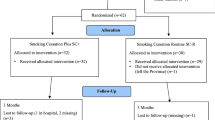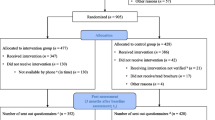Abstract
A random sample of clinical psychologists was surveyed regarding their smoking cessation practices and perceptions. A total of 352 psychologists responded (57%) to the valid and reliable questionnaire. The majority (59.1%) of psychologists did not always identify and document the smoking status of patients. The majority reported high efficacy expectations (66.4%) and low outcome expectations (55.1%) for using the 5A’s smoking cessation counseling technique. Counselors that had never smoked were almost two times more likely to have higher efficacy expectations than those that were current smokers or ex-smokers (OR = 1.94, 95% CI 1.18–3.12). The factors that predicted regular use of the 5A’s included the number of identified barriers, psychologists’ level of self efficacy, and the urbanicity of one’s practice location.
Similar content being viewed by others
References
Center for Disease Control, Prevention. (1999). Achievements in public health, 1900–1999: Tobacco use—United States, 1900–1999. MMWR Morbidity and Mortality Weekly Reports, 48(43), 986–993.
Center for Disease Control, Prevention. (2008). Smoking-attributable mortality, years of potential life last, and productivity losses—United States, 2000–2004. MMWR Morbidity and Mortality Weekly Reports, 57(45), 1226–1228.
Chaloupka, F., Jha, P., Corrao, M. A., et al. (2003). Global efforts for reducing the burden of smoking. Disease Management and Health Outcomes, 11, 647–661.
Center for Disease Control, Prevention. (2004). Cigarette smoking among adults—United States, 2002. MMWR Morbidity and Mortality Weekly Reports, 57(45), 1221–1226.
Center for Disease Control, Prevention. (2006). Cigarette smoking among adults—United States, 2005. MMWR Morbidity and Mortality Weekly Reports, 55, 1145–1148.
Giovino, G. (2007). Overview: The tobacco epidemic in the United States. American Journal of Preventive Medicine, 33, s318–s326.
Fiore, M. C., Jaen C.R., Baker, T.B., et al. (2008). Treating tobacco use and dependence: 2008 update. Rockville, MD U.S. Department to Health and Human Services, Public Health Service.
Breslau, N., Novak, S. P., & Kessler, R. C. (2004). Psychiatric disorders and stages of smoking. Biological Psychiatry, 55(1), 69–76.
Leonard, S., Adler, L. E., Benhammou, K., Berger, R., et al. (2001). Smoking and mental illness. Pharmacology and Biochemical Behavior, 70(4), 561–570.
Grant, B. F., Hasin, S. D., Chou, P., Stinson, F. S., & Dawson, D. A. (2004). Nicotine dependence and psychiatric disorders in the United States: Results from the national epidemiologic survey on alcohol and related conditions. Archives of General Psychiatry, 61, 1107–1115.
Cinciripini, P. M., Wetter, D. W., Fouladi, R. T., Blalock, J. A., Carter, B. L., Cinciripini, L. G., et al. (2003). The effects of depressed mood on smoking cessation: Mediation by postcessation self-efficacy. Journal of Consulting and Clinical Psychology, 71(2), 292–301.
Murphy, J. M., Horton, N. J., Monson, R. R., Laird, N. M., Sobol, A. M., & Leighton, A. H. (2003). Cigarette smoking in relation to depression: Historical trends from the Stirling county study. American Journal of Psychiatry, 160, 1663–1669.
Paperwalla, K. N., Levin, T. T., Weiner, J., & Saravay, S. M. (2004). Smoking and depression. Medicine Clinics of North America, 88, 1483–1494.
Vickers, K. S., Patten, C. A., Lane, K., et al. (2003). Depressed versus non-depressed young adult tobacco users: Differences in coping style, weight concerns, and exercise level. Health Psychology, 22(5), 498–503.
Phillips, K. M., & Brandon, T. H. (2004). Do psychologists adhere to the clinical practice guidelines for tobacco cessation? A Survey of practitioners. Professional Psychology, Research and Practice, 35(3), 281–285.
Balch, G. I. (1998). Exploring perceptions of smoking cessation among high school smokers: Input and feedback from focus groups. Preventive Medicine, 27(5), Part B, A55–A63.
Mojica, W. A., Suttorp, M. J., Sherman, S. E., et al. (2004). Smoking-cessation interventions by type of provider: A meta-analysis. American Journal of Preventive Medicine, 26(5), 391–401.
Pingitore, D. P., Sheffler, R. M., Sentell, T., & West, J. C. (2002). Comparison of psychiatrists and psychologists in clinical practice. Psychiatric Services, 53(8), 977–983.
Wendt, S. J. (2005). Smoking cessation and exercise promotion counseling in psychologists who practice psychotherapy. American Journal of Health Promotion, 19(95), 339–345.
Hjalmarson, A., & Saloojee, Y. (2005). Psychologists and tobacco: Attitudes to cessation and patterns of use. Preventive Medicine, 41, 291–294.
Leffingwell, T. R., & Babitzke, A. C. (2006). Tobacco intervention practices of licensed psychologists. Journal of Clinical Psychology, 62, 313–323.
Price, J. H., Dake, J. A., Murnan, J., Dimming, J., & Akpanudo, S. M. (2005). Power analysis in survey research: Importance and use for health educators. American Journal of Health Education, 36(4), 202–207.
Prochaska, J. O., & DiClemente, C. C. (1982). Transtheoretical therapy toward a more integrative model of change. Psychotherapy: Theory, Research and Practice, 19(3), 276–287.
Harrison, J. A., Mullen, P. D., & Green, L. W. (1992). A meta-analysis of studies of the health belief model with adults. Health Education Research, 7, 107–116.
Bandura, A. (1977). Self-efficacy: Towards a unifying theory of behavioral change. Psychological Review, 84(2), 191–215.
Edwards, P., Roberts, I., Clarke, M., et al. (2002). Increasing response rates to postal questionnaire: Systemic review. British Medical Journal, 324(7347), 1183.
King, K. A., Pealer, L. N., & Bernard, A. L. (2001). Increasing response rates to mail questionnaires: A review of inducement strategies. American Journal of Health Education, 32, 4–15.
Ulrich, C. M., Danis, M., Koziol, D., Garrett-Mayer, E., Hubbard, R., & Grady, C. (2005). Does it pay to pay? A randomized trial of prepaid financial incentives and lottery incentives in surveys of non-physician healthcare professionals. Nursing Research, 54(3), 178–183.
Katz, D. A., Muehlenbruch, D. R., Brown, R. B., Fiore, M. C., & Baker, T. B. (2002). Effectiveness of a clinic-based strategy for implementing the AHRQ smoking cessation guideline in primary care. Preventive Medicine, 35(3), 293–302.
Sippel, J. M., Osborne, M. L., Bjornson, W., Goldberg, B., & Buist, A. S. (1999). Smoking cessation in primary care clinics. Journal of General Internal Medicine, 99(14), 670–676.
Ward, M. M., Doebbeling, B. N., Vaughn, T. E., et al. (2003). Effectiveness of a nationally implemented smoking cessation guideline on provider and patient practices. Preventive Medicine, 36(3), 265–271.
Moon, M. N. (2002). Psychiatrist don’t deliver ‘quit smoking’ message. Clinical Psychiatry News, 8.
An, L. C., Foldes, S. S., Alesci, N. L., et al. (2008). The impact of smoking-cessation interventions by multiple health professionals. American Journal of Preventive Medicine, 34, 54–59.
Nicholson, J. M., Hennrikus, D. J., Lando, H. A., McCarty, M. C., & Vessey, J. (2000). Patient recall versus physician documentation in report of smoking cessation counseling performed in the inpatient setting. Tobacco Control, 9, 382–388.
Rogers, L. Q., Johnson, K. C., Young, Z. M., & Graney, M. (1997). Demographic bias in physician smoking cessation counseling. American Journal of Medical Sciences, 313(3), 153–158.
Sarna, L. P., Brown, J. K., Lillington, L., Rose, M., Wewers, M. E., & Brecht, M. (2000). Tobacco interventions by oncology nurses in clinical practice. Cancer, 89(4), 881–889.
Hughes, J. R. (2003). Motivation and helping smokers to stop smoking. Journal of General Internal Medicine, 18, 1053–1057.
Lancaster, T., Stead, L., Silagy, C., & Sowden, A. (2000). Effectiveness of interventions to help people stop smoking: Findings from the Cochrane library. British Medical Journal, 321, 355–358.
Milch, C. E., Edmunson, J. M., Beshansky, J. R., Griffith, J. L., & Selker, H. P. (2004). Smoking cessation in primary care: A clinical effectiveness trial of two simple interventions. Preventive Medicine, 38(3), 284–294.
Prochaska, J. O., Velicer, W. F., Prochaska, J. M., & Johnson, J. L. (2004). Size, consistency, and stability of stage effects for smoking cessation. Addictive Behavior, 29(1), 207–213.
Yılmaz, G., Karacan, C., Yöney, A., & Yılmaz, T. (2006). Brief intervention on maternal smoking: A randomized controlled trial. Child Care and Health Development, 32(1), 73–79.
Borrelli, B., Hecht, J. P., Papandonatos, G. D., Emmons, K. M., Tatewosian, L. R., & Abrams, D. B. (2001). Smoking-cessation counseling in the home: Attitudes, beliefs, and behaviors of home healthcare nurses. American Journal of Preventive Medicine, 21(4), 272–277.
Gottlieb, N. H., Guo, J. L., Blozis, S. A., Blozis, S. A., & Huang, P. P. (2001). Individual and contextual factors related to family practice residents’ assessment and counseling for tobacco cessation. Journal of the American Board of Family Practice, 14, 343–351.
Anthenelli, R. M. (2005). How and why to help psychiatric patients stop smoking. Current Psychiatry, 4, 77–97.
Isensee, B., Wittchen, H., Stein, M. B., Hofler, M., & Lieb, R. (2003). Smoking increases the risk of panic: Findings from a prospective community study. Archives of General Psychiatry, 60, 692–700.
Rohde, P., Lewinsohn, P. M., Brown, R. A., Gau, J. M., & Kahler, C. W. (2003). Psychiatric disorders, familial factors and cigarette smoking: I. Association with smoking initiation. Nicotine & Tobacco Research, 5, 85–98.
Horn, K., Dino, G., Kalsekar, I., Massey, C. J., Manzo-Tennant, K., & McGloin, T. (2004). Exploring the relationship between mental health and smoking cessation: A study of rural teens. Preventive Science, 5(2), 113–126.
Kalman, D. (1998). Smoking cessation treatment for substance misusers in early recovery: A review of the literature and recommendations for practice. Substance Use and Misuse, 33(10), 2021–2047.
Hurt, R. D., Offord, K. P., Croghan, I. T., et al. (1996). Mortality following inpatient addictions treatment. Role of tobacco use in a community-based cohort. Journal of the American Medical Association, 276(10), 783–784.
Cummings, K. M., & Hyland, A. (2005). Impact of nicotine replacement therapy on smoking behavior. Annual Review Public Health, 26, 583–599.
Lerman, C., Patterson, F., & Berrettini, W. (2005). Treating tobacco dependence: State of the science and new directions. Journal of Clinical Oncology, 23(2), 311–323.
Price, J. H., Jordan, T., & Dake, J. A. (2005). Pediatricians’ Use of the 5A’s and nicotine replacement therapy with adolescent smokers. Journal of Community Health, 32, 85–101.
Author information
Authors and Affiliations
Corresponding author
Rights and permissions
About this article
Cite this article
Akpanudo, S.M., Price, J.H., Jordan, T. et al. Clinical Psychologists and Smoking Cessation: Treatment Practices and Perceptions. J Community Health 34, 461–471 (2009). https://doi.org/10.1007/s10900-009-9178-0
Published:
Issue Date:
DOI: https://doi.org/10.1007/s10900-009-9178-0




